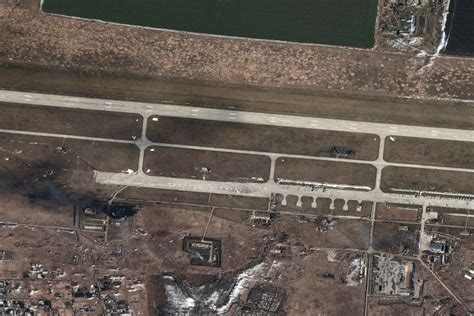
Satellite imagery appears to confirm Ukraine’s claims of successfully striking Russian airfields, showing significant damage to several strategic bombers at the Pskov airbase, according to recent reports. The images, analyzed by various sources, including defense analysts and open-source intelligence groups, reveal what appear to be the charred remains of aircraft and evidence of explosions, bolstering Kyiv’s assertion that it inflicted substantial losses on the Russian Air Force in a recent drone attack.
Satellite photos analyzed indicate that at least two, and potentially more, Russian IL-76 transport planes were destroyed in the attack. The images show substantial fire damage to the aircraft and nearby structures. While Russia has not officially confirmed the extent of the damage, the available evidence from independent sources lends credence to Ukraine’s claims. The attack, if confirmed to the scale indicated by the satellite imagery, represents a significant blow to Russia’s military capabilities, particularly its long-range aviation assets.
Ukraine has increasingly targeted logistical hubs and military infrastructure within Russia, demonstrating an enhanced capacity to strike deep inside Russian territory. These operations are seen as a crucial element of Ukraine’s broader strategy to degrade Russia’s ability to sustain its war effort. The attacks also serve as a demonstration of Ukraine’s resolve and capability, even as it continues to confront ongoing challenges on the front lines.
The use of drones in these attacks highlights a shift in the dynamics of the conflict, with unmanned aerial vehicles playing an increasingly prominent role in both offensive and defensive operations. The relative affordability and accessibility of drones make them an attractive option for Ukraine, allowing it to conduct targeted strikes against high-value targets without risking manned aircraft. The sophistication and range of these drones are also improving, enabling them to penetrate deeper into enemy territory and strike with greater precision.
The incident raises concerns about the vulnerability of Russian airbases and the effectiveness of Russia’s air defenses. Questions are being asked about how Ukrainian drones were able to penetrate so far into Russian airspace and successfully strike such a sensitive target. The incident also underscores the escalating nature of the conflict and the potential for further escalation, as both sides continue to seek ways to gain an advantage.
The Pskov airfield, located approximately 400 miles (650 kilometers) from the Ukrainian border, holds strategic importance for Russia, serving as a base for military transport aircraft and potentially bomber squadrons. The confirmed damage to aircraft at this location raises serious concerns regarding Russia’s logistical capabilities and overall military preparedness.
Further analysis of the satellite imagery is underway to determine the full extent of the damage and to ascertain the types of munitions used in the attack. Open-source intelligence analysts and military experts are closely monitoring the situation and providing ongoing assessments of the evolving situation. The incident is likely to have significant implications for the future course of the conflict and will undoubtedly prompt a reassessment of security measures at Russian military facilities.
Expanded Coverage and Analysis:
The attack on the Pskov airbase is not an isolated incident. It follows a series of similar strikes against Russian targets, including oil refineries, ammunition depots, and other military installations. These attacks suggest a coordinated effort by Ukraine to disrupt Russian supply lines and degrade its military capabilities. The increasing frequency and sophistication of these attacks are raising concerns within Russia and prompting calls for a stronger response.
The Kremlin has so far refrained from commenting directly on the Pskov attack, but Russian military bloggers and media outlets have acknowledged the incident and expressed outrage over what they describe as a “security failure.” Some have called for retaliatory strikes against Ukrainian targets, while others have criticized the Russian military for its perceived lack of preparedness.
The use of drones in the Pskov attack is particularly noteworthy. While Ukraine has previously used drones to strike targets inside Russia, the scale and precision of this attack suggest a significant advancement in Ukraine’s drone capabilities. It is believed that Ukraine is developing its own long-range drones with the assistance of foreign partners. These drones are designed to evade Russian air defenses and strike with pinpoint accuracy.
The implications of the Pskov attack extend beyond the immediate military damage. The attack also serves as a propaganda victory for Ukraine, demonstrating its ability to strike deep inside Russian territory and undermine the Kremlin’s narrative of a “special military operation” that is proceeding according to plan. The attack is likely to boost morale among Ukrainian forces and bolster public support for the war effort.
The attack also raises questions about the future of the conflict. As Ukraine continues to develop its long-range strike capabilities, it is likely to conduct more attacks against targets inside Russia. These attacks could escalate the conflict and potentially draw NATO into a direct confrontation with Russia.
The international community has largely condemned the attacks on civilian targets in Ukraine, but there is less consensus on the legality and morality of attacks on military targets inside Russia. Some argue that Ukraine has a right to defend itself by any means necessary, including striking targets that are used to support the Russian war effort. Others argue that such attacks could escalate the conflict and lead to unintended consequences.
The United States and its allies have provided Ukraine with billions of dollars in military aid, including advanced weapons systems. However, they have also cautioned Ukraine against using these weapons to attack targets inside Russia. The US fears that such attacks could provoke a strong reaction from Russia and potentially lead to a wider war.
The Pskov attack is a reminder of the risks of escalation in the Ukraine conflict. As both sides become more entrenched and determined to win, the potential for miscalculation and unintended consequences increases. The international community must work to de-escalate the conflict and find a peaceful resolution before it spirals out of control.
Beyond the immediate tactical implications, the Pskov attack highlights a more profound strategic shift in the war. Ukraine’s demonstrated ability to project force deep into Russian territory challenges Russia’s perception of invulnerability and forces Moscow to re-evaluate its defensive posture. This necessitates the diversion of resources to protect strategic assets within Russia, potentially straining Russia’s already overstretched military.
Moreover, the psychological impact of these attacks should not be underestimated. The attacks undermine public confidence in the Russian government’s ability to protect its citizens and infrastructure, fueling discontent and questioning of the war’s objectives. This internal pressure could eventually influence Moscow’s decision-making process.
The drones used in the Pskov attack are believed to be a mix of domestically produced and foreign-supplied models. Ukraine has been actively developing its own drone industry, focusing on long-range, precision-guided munitions. The success of these drones in penetrating Russian air defenses underscores the effectiveness of Ukraine’s technological advancements.
Russia’s air defense systems, while formidable, have proven vulnerable to drone attacks. This vulnerability may be attributed to several factors, including the sheer number of drones being launched, the drones’ low radar cross-section, and the saturation of air defense systems. Russia is likely to invest heavily in improving its air defenses to counter this growing threat.
The international community is closely watching the developments in Ukraine, with many countries providing humanitarian and military assistance. However, there is a growing concern about the potential for a wider conflict. The United States and its allies have repeatedly warned Russia against using nuclear weapons, but the risk of escalation remains.
The war in Ukraine is a complex and multifaceted conflict with no easy solutions. The Pskov attack is just one example of the many challenges and uncertainties that lie ahead. The international community must remain engaged and work together to find a peaceful resolution to the conflict before it leads to further devastation and loss of life.
The type of drones used in the Pskov attack are speculated to be a variant of UJ-22 Airborne drones, equipped for long-range strikes and GPS guided navigation. The Russian defenses failed to locate the drones which are made of composite materials making them harder to detect.
The destruction of IL-76 transport planes is a setback for Russia. These planes are critical for transporting troops, equipment, and supplies. The loss of several of these planes could disrupt Russia’s logistical operations and make it more difficult to sustain its war effort. The impact on the war could be huge if Ukraine continues to successfully target and destroy vital military equipment.
Quote from the original source: While the Yahoo News article does not contain direct quotes, the information presented is derived from multiple sources including open-source intelligence analysts, defense experts, and satellite imagery analysis, all contributing to the reconstruction of events and assessment of damages.
Frequently Asked Questions (FAQ):
Q1: What exactly happened at the Pskov airbase, according to available reports?
A1: Satellite imagery and reports suggest that Ukraine conducted a drone attack on the Pskov airbase in Russia, resulting in significant damage to multiple Russian IL-76 military transport planes. The images indicate fire damage and potential destruction of aircraft, supporting Ukraine’s claims of a successful strike. The scale of the damage is still being assessed, but initial findings suggest a substantial blow to Russia’s military assets.
Q2: How far is the Pskov airbase from the Ukrainian border, and why is this significant?
A2: The Pskov airbase is approximately 400 miles (650 kilometers) from the Ukrainian border. This distance is significant because it demonstrates Ukraine’s growing capacity to strike targets deep inside Russian territory, raising concerns about the vulnerability of Russian strategic sites and air defenses.
Q3: What kind of drones were likely used in the attack, and what makes them effective?
A3: The exact type of drones used remains unconfirmed, but it’s speculated to be a variant of UJ-22 Airborne drones, or similar long-range models that were likely used. These are equipped for long-range strikes and GPS guided navigation. Also made of composite materials, making them harder to detect. These drones are effective due to their ability to evade radar detection, their precision targeting capabilities, and their relative affordability compared to manned aircraft. Ukraine has been actively developing its domestic drone industry and also receiving support from foreign partners.
Q4: What is the strategic importance of the IL-76 aircraft that were reportedly damaged or destroyed?
A4: IL-76 aircraft are crucial for Russia’s military logistics, serving as the primary means of transporting troops, equipment, and supplies. The destruction of these planes could significantly disrupt Russia’s ability to sustain its operations, particularly in areas far from its borders. This loss also forces Russia to re-evaluate its logistical strategies and potentially divert resources to repair or replace damaged aircraft.
Q5: What are the potential implications of this attack for the wider conflict and for international relations?
A5: The attack has several potential implications. Militarily, it demonstrates Ukraine’s evolving capabilities to strike deep inside Russia, potentially escalating the conflict. It forces Russia to reassess its air defenses and protect strategic assets, straining its resources. Psychologically, it boosts Ukrainian morale and undermines confidence in the Russian government. Internationally, it raises questions about the legality of attacks on military targets inside Russia and increases the risk of a wider conflict involving NATO. It also underscores the need for de-escalation and a peaceful resolution to the conflict.
Further Analysis of the Implications and Context:
The Pskov airfield attack underscores the changing dynamics of the war in Ukraine. It moves beyond traditional front-line warfare, showcasing Ukraine’s asymmetric warfare capabilities. By targeting strategic assets deep within Russia, Ukraine is attempting to shift the conflict’s center of gravity, disrupting Russian supply lines, raising the cost of the war for Russia, and impacting domestic morale.
Impact on Russian Logistics and Military Operations:
The loss of IL-76 transport aircraft has a direct impact on Russia’s ability to move troops, equipment, and supplies, especially to remote or contested regions. This could lead to delays in troop deployments, shortages of essential supplies, and disruptions to planned military operations. The need to compensate for these losses could strain Russia’s already stretched resources and force it to prioritize certain operations over others.
Evolution of Drone Warfare:
The increasing use of drones in the conflict highlights the evolving nature of modern warfare. Drones offer several advantages over traditional weapons systems, including lower cost, reduced risk to personnel, and increased precision. The success of the Pskov attack suggests that drones are becoming an increasingly important component of Ukraine’s military strategy and a major challenge for Russian air defenses.
Psychological Warfare and Domestic Morale:
The attacks on Russian territory have a significant psychological impact, both on the Ukrainian and Russian populations. For Ukrainians, these attacks provide a morale boost and demonstrate the country’s ability to strike back at its aggressor. For Russians, the attacks raise questions about the government’s ability to protect its own territory and fuel discontent with the war.
Escalation Risks and International Law:
The attacks on military targets inside Russia raise complex questions under international law. While Ukraine has the right to defend itself against aggression, the legality of attacks on targets within Russia depends on several factors, including the nature of the targets and the proportionality of the response. Some argue that attacks on military targets that directly support the Russian war effort are permissible under international law, while others argue that such attacks could escalate the conflict and violate the principle of proportionality.
Impact on Russian Air Defenses:
The Pskov attack exposes vulnerabilities in Russia’s air defense systems. Despite having some of the most advanced air defense systems in the world, Russia has struggled to effectively counter drone attacks. This may be due to a combination of factors, including the drones’ low radar cross-section, the sheer number of drones being launched, and the saturation of air defense systems. Russia will likely need to invest heavily in improving its air defenses to counter this growing threat. This will divert resources from other areas and put further strain on the country’s military budget.
International Response and Alliances:
The international community remains divided on the conflict in Ukraine. While many countries have condemned Russia’s aggression and provided assistance to Ukraine, others have been more hesitant to take sides. The attacks on Russian territory could further complicate international relations and make it more difficult to forge a united front against Russia. The United States and its allies have repeatedly warned Russia against using nuclear weapons, but the risk of escalation remains.
Long-Term Strategic Implications:
The war in Ukraine is likely to have long-term strategic implications for Europe and the world. The conflict has exposed vulnerabilities in European security architecture and prompted a reassessment of NATO’s role. It has also accelerated the trend toward great power competition and increased the risk of future conflicts. The international community must work to prevent further escalation and find a peaceful resolution to the conflict before it leads to even greater devastation.
The evolving nature of the conflict necessitates ongoing analysis and adaptation. Military strategists, policymakers, and international organizations must closely monitor developments in Ukraine and develop strategies to address the challenges posed by the war. This includes providing support to Ukraine, deterring further Russian aggression, and promoting a peaceful resolution to the conflict. The satellite images, while not definitively confirming the exact cause of the damage, provide compelling visual evidence supporting Ukraine’s claims. The incident serves as a stark reminder of the vulnerability of military infrastructure, even in seemingly secure locations. The attacks on Russian territory raise questions about the limits of self-defense and the potential for escalation in armed conflicts.
Economic Ramifications:
Beyond the immediate military implications, the ongoing attacks and the wider conflict are having significant economic ramifications. The disruption to trade routes, the rise in energy prices, and the increased military spending are all contributing to global economic instability. The cost of rebuilding Ukraine after the war will be enormous, and the international community will need to provide significant financial assistance.
The incident at Pskov will likely spur Russia to re-evaluate its security protocols for its critical infrastructure. This may involve increased deployment of air defense systems, enhanced surveillance, and stricter access controls. However, these measures will come at a cost and could divert resources from other important areas.
Geopolitical Ramifications:
The attack at Pskov underscores the growing tensions between Russia and Ukraine, as well as the broader geopolitical implications for the region. The incident will likely further strain relations between Russia and the West, as accusations and counter-accusations fly. The conflict has also emboldened other actors in the region, creating new challenges for international diplomacy.
The use of drones in the attack highlights the accessibility and affordability of this technology, making it a potent weapon for both state and non-state actors. This proliferation of drone technology presents a challenge for international security, as it makes it easier for actors to conduct attacks without risking human lives.
Environmental Considerations:
The ongoing conflict in Ukraine is also having a significant impact on the environment. The destruction of infrastructure, the use of heavy weaponry, and the displacement of populations are all contributing to environmental degradation. The long-term consequences of this damage will be felt for years to come.
The incident serves as a reminder of the human cost of war. The conflict in Ukraine has already displaced millions of people and claimed the lives of thousands. The long-term consequences of this trauma will be felt for generations to come.
Technological Warfare Advancement:
The conflict continues to spur advancements in military technology, with both sides seeking new and innovative ways to gain an advantage. The use of drones, electronic warfare systems, and cyber warfare tactics is becoming increasingly common, blurring the lines between traditional and unconventional warfare.
Ethical Warfare Debate:
The use of drones in warfare raises ethical questions about the targeting of individuals and the potential for civilian casualties. The debate over the legality and morality of drone warfare is likely to continue, as the technology becomes more prevalent.
The international community must work together to establish clear rules of engagement for drone warfare, to ensure that these weapons are used responsibly and ethically.
Alternative Scenarios:
While the available evidence points to a successful Ukrainian drone attack, alternative scenarios cannot be completely ruled out. For instance, the damage could have been caused by a malfunction or accident at the airbase. However, given the context of the ongoing conflict and Ukraine’s demonstrated capabilities, a drone attack remains the most likely explanation.
Even if the attack was not as successful as initially claimed, it still serves as a reminder of the vulnerability of Russian military infrastructure and the potential for escalation in the conflict.
The incident at Pskov underscores the need for a comprehensive and long-term strategy for addressing the conflict in Ukraine. This strategy should include military support for Ukraine, economic sanctions against Russia, and diplomatic efforts to find a peaceful resolution to the conflict.









